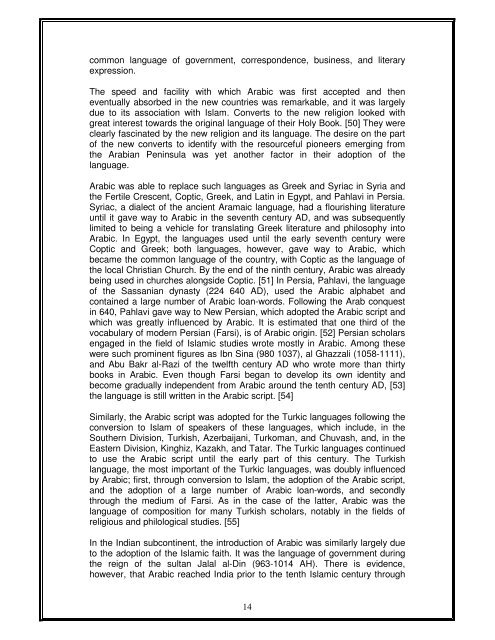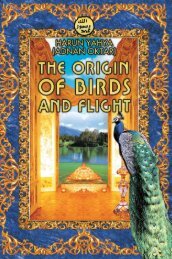Islam, the Qur'an and the Arabic Literature
Islam, the Qur'an and the Arabic Literature
Islam, the Qur'an and the Arabic Literature
You also want an ePaper? Increase the reach of your titles
YUMPU automatically turns print PDFs into web optimized ePapers that Google loves.
common language of government, correspondence, business, <strong>and</strong> literary<br />
expression.<br />
The speed <strong>and</strong> facility with which <strong>Arabic</strong> was first accepted <strong>and</strong> <strong>the</strong>n<br />
eventually absorbed in <strong>the</strong> new countries was remarkable, <strong>and</strong> it was largely<br />
due to its association with <strong>Islam</strong>. Converts to <strong>the</strong> new religion looked with<br />
great interest towards <strong>the</strong> original language of <strong>the</strong>ir Holy Book. [50] They were<br />
clearly fascinated by <strong>the</strong> new religion <strong>and</strong> its language. The desire on <strong>the</strong> part<br />
of <strong>the</strong> new converts to identify with <strong>the</strong> resourceful pioneers emerging from<br />
<strong>the</strong> Arabian Peninsula was yet ano<strong>the</strong>r factor in <strong>the</strong>ir adoption of <strong>the</strong><br />
language.<br />
<strong>Arabic</strong> was able to replace such languages as Greek <strong>and</strong> Syriac in Syria <strong>and</strong><br />
<strong>the</strong> Fertile Crescent, Coptic, Greek, <strong>and</strong> Latin in Egypt, <strong>and</strong> Pahlavi in Persia.<br />
Syriac, a dialect of <strong>the</strong> ancient Aramaic language, had a flourishing literature<br />
until it gave way to <strong>Arabic</strong> in <strong>the</strong> seventh century AD, <strong>and</strong> was subsequently<br />
limited to being a vehicle for translating Greek literature <strong>and</strong> philosophy into<br />
<strong>Arabic</strong>. In Egypt, <strong>the</strong> languages used until <strong>the</strong> early seventh century were<br />
Coptic <strong>and</strong> Greek; both languages, however, gave way to <strong>Arabic</strong>, which<br />
became <strong>the</strong> common language of <strong>the</strong> country, with Coptic as <strong>the</strong> language of<br />
<strong>the</strong> local Christian Church. By <strong>the</strong> end of <strong>the</strong> ninth century, <strong>Arabic</strong> was already<br />
being used in churches alongside Coptic. [51] In Persia, Pahlavi, <strong>the</strong> language<br />
of <strong>the</strong> Sassanian dynasty (224 640 AD), used <strong>the</strong> <strong>Arabic</strong> alphabet <strong>and</strong><br />
contained a large number of <strong>Arabic</strong> loan-words. Following <strong>the</strong> Arab conquest<br />
in 640, Pahlavi gave way to New Persian, which adopted <strong>the</strong> <strong>Arabic</strong> script <strong>and</strong><br />
which was greatly influenced by <strong>Arabic</strong>. It is estimated that one third of <strong>the</strong><br />
vocabulary of modern Persian (Farsi), is of <strong>Arabic</strong> origin. [52] Persian scholars<br />
engaged in <strong>the</strong> field of <strong>Islam</strong>ic studies wrote mostly in <strong>Arabic</strong>. Among <strong>the</strong>se<br />
were such prominent figures as Ibn Sina (980 1037), al Ghazzali (1058-1111),<br />
<strong>and</strong> Abu Bakr al-Razi of <strong>the</strong> twelfth century AD who wrote more than thirty<br />
books in <strong>Arabic</strong>. Even though Farsi began to develop its own identity <strong>and</strong><br />
become gradually independent from <strong>Arabic</strong> around <strong>the</strong> tenth century AD, [53]<br />
<strong>the</strong> language is still written in <strong>the</strong> <strong>Arabic</strong> script. [54]<br />
Similarly, <strong>the</strong> <strong>Arabic</strong> script was adopted for <strong>the</strong> Turkic languages following <strong>the</strong><br />
conversion to <strong>Islam</strong> of speakers of <strong>the</strong>se languages, which include, in <strong>the</strong><br />
Sou<strong>the</strong>rn Division, Turkish, Azerbaijani, Turkoman, <strong>and</strong> Chuvash, <strong>and</strong>, in <strong>the</strong><br />
Eastern Division, Kinghiz, Kazakh, <strong>and</strong> Tatar. The Turkic languages continued<br />
to use <strong>the</strong> <strong>Arabic</strong> script until <strong>the</strong> early part of this century. The Turkish<br />
language, <strong>the</strong> most important of <strong>the</strong> Turkic languages, was doubly influenced<br />
by <strong>Arabic</strong>; first, through conversion to <strong>Islam</strong>, <strong>the</strong> adoption of <strong>the</strong> <strong>Arabic</strong> script,<br />
<strong>and</strong> <strong>the</strong> adoption of a large number of <strong>Arabic</strong> loan-words, <strong>and</strong> secondly<br />
through <strong>the</strong> medium of Farsi. As in <strong>the</strong> case of <strong>the</strong> latter, <strong>Arabic</strong> was <strong>the</strong><br />
language of composition for many Turkish scholars, notably in <strong>the</strong> fields of<br />
religious <strong>and</strong> philological studies. [55]<br />
In <strong>the</strong> Indian subcontinent, <strong>the</strong> introduction of <strong>Arabic</strong> was similarly largely due<br />
to <strong>the</strong> adoption of <strong>the</strong> <strong>Islam</strong>ic faith. It was <strong>the</strong> language of government during<br />
<strong>the</strong> reign of <strong>the</strong> sultan Jalal al-Din (963-1014 AH). There is evidence,<br />
however, that <strong>Arabic</strong> reached India prior to <strong>the</strong> tenth <strong>Islam</strong>ic century through<br />
14




